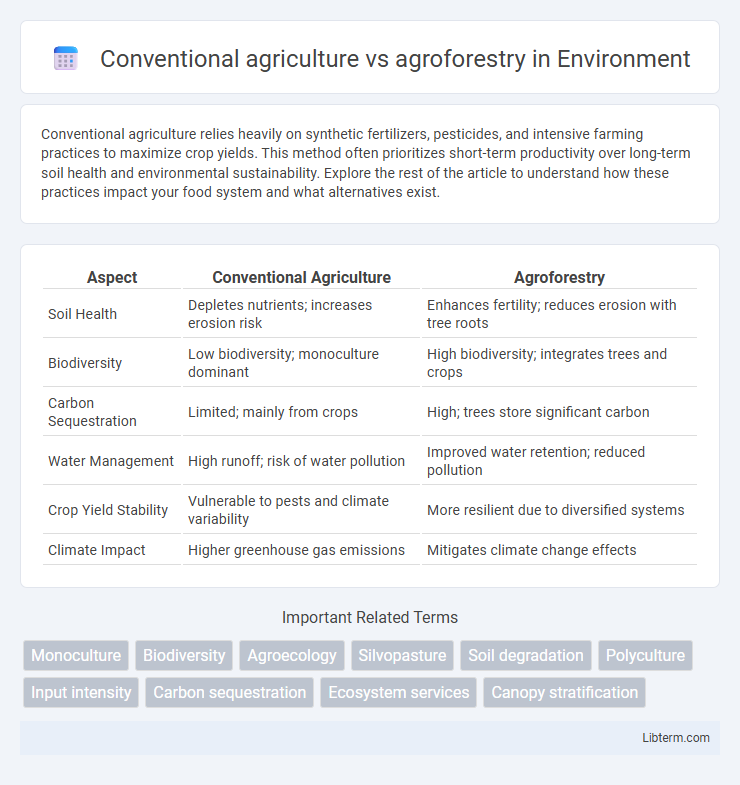Conventional agriculture relies heavily on synthetic fertilizers, pesticides, and intensive farming practices to maximize crop yields. This method often prioritizes short-term productivity over long-term soil health and environmental sustainability. Explore the rest of the article to understand how these practices impact your food system and what alternatives exist.
Table of Comparison
| Aspect | Conventional Agriculture | Agroforestry |
|---|---|---|
| Soil Health | Depletes nutrients; increases erosion risk | Enhances fertility; reduces erosion with tree roots |
| Biodiversity | Low biodiversity; monoculture dominant | High biodiversity; integrates trees and crops |
| Carbon Sequestration | Limited; mainly from crops | High; trees store significant carbon |
| Water Management | High runoff; risk of water pollution | Improved water retention; reduced pollution |
| Crop Yield Stability | Vulnerable to pests and climate variability | More resilient due to diversified systems |
| Climate Impact | Higher greenhouse gas emissions | Mitigates climate change effects |
Introduction to Conventional Agriculture and Agroforestry
Conventional agriculture relies heavily on monoculture practices, synthetic fertilizers, and pesticides to maximize crop yields on large-scale farms, often leading to soil degradation and reduced biodiversity. Agroforestry integrates trees and shrubs into crop and livestock systems, enhancing soil health, increasing biodiversity, and improving ecosystem services such as carbon sequestration and water retention. This sustainable land-use approach promotes long-term productivity by mimicking natural ecosystems and reducing the environmental impacts associated with conventional farming methods.
Defining Characteristics of Conventional Agriculture
Conventional agriculture is characterized by monoculture practices, heavy reliance on synthetic fertilizers, pesticides, and herbicides to maximize crop yield, and the extensive use of mechanization for planting and harvesting. This approach often leads to soil degradation, reduced biodiversity, and increased greenhouse gas emissions due to intensive land use and chemical inputs. In contrast to agroforestry, conventional agriculture typically lacks integrated tree cover and diversified crop systems, which can diminish ecosystem resilience and sustainability.
Core Principles of Agroforestry Systems
Agroforestry systems integrate trees, crops, and livestock on the same land to optimize biodiversity, enhance soil health, and improve water retention, contrasting with conventional agriculture's focus on monoculture and intensive chemical inputs. Core principles include ecological synergy, sustainable resource management, and diversified production to reduce environmental impact and increase resilience. This approach promotes nutrient cycling, natural pest control, and carbon sequestration, making it a sustainable alternative to traditional farming methods.
Environmental Impacts: A Comparative Analysis
Conventional agriculture often leads to soil degradation, reduced biodiversity, and increased greenhouse gas emissions due to monoculture practices and intensive chemical use. Agroforestry enhances environmental sustainability by integrating trees with crops or livestock, improving soil health, carbon sequestration, and promoting biodiversity. Studies show agroforestry systems can reduce soil erosion by up to 50% and increase carbon storage significantly compared to conventional farming methods.
Biodiversity in Conventional Farms vs. Agroforestry Landscapes
Conventional agriculture typically relies on monoculture practices, which reduce habitat diversity and lead to significant declines in local biodiversity. Agroforestry landscapes integrate trees with crops or livestock, creating multi-layered habitats that support a wider range of species, including pollinators, birds, and beneficial insects. Studies show that agroforestry systems can enhance ecosystem services by promoting soil health, improving nutrient cycling, and increasing overall biodiversity compared to conventional farms.
Soil Health and Fertility Management
Conventional agriculture often relies on synthetic fertilizers and monocropping, which can deplete soil nutrients and reduce microbial diversity, leading to long-term soil degradation. Agroforestry integrates trees with crops and livestock, enhancing soil structure, increasing organic matter, and promoting nutrient cycling through nitrogen fixation and litter decomposition. This sustainable approach improves soil fertility, water retention, and resilience against erosion, supporting healthier and more productive ecosystems.
Water Use and Conservation Practices
Conventional agriculture often relies on intensive irrigation methods that can deplete water resources and reduce soil moisture retention, leading to increased runoff and erosion. Agroforestry integrates trees with crops and livestock, enhancing water infiltration, reducing evaporation, and improving groundwater recharge through deeper root systems. This sustainable practice promotes efficient water use, conserves soil moisture, and mitigates drought impacts by creating microclimates that protect crops and reduce water stress.
Economic Viability and Farm Productivity
Conventional agriculture often yields higher short-term farm productivity through monoculture practices that maximize immediate crop output, but it can lead to soil degradation and reduced long-term economic viability. Agroforestry, which integrates trees with crops or livestock, enhances soil fertility, diversifies income sources, and improves resilience to climate variability, supporting sustainable economic viability. Studies indicate agroforestry systems can increase total farm productivity by optimizing resource use and generating multiple revenue streams compared to conventional monocultures.
Climate Change Mitigation Potential
Conventional agriculture often relies on monoculture practices that contribute significantly to greenhouse gas emissions and soil degradation, limiting its climate change mitigation potential. Agroforestry integrates trees with crops and livestock, enhancing carbon sequestration in biomass and soils while improving biodiversity and resilience to climate impacts. Studies show agroforestry systems can store up to 50% more carbon than conventional agriculture, making them a vital strategy for reducing atmospheric CO2 levels.
Future Perspectives and Sustainable Development
Conventional agriculture often depletes soil nutrients and relies heavily on chemical inputs, threatening long-term sustainability and biodiversity. Agroforestry integrates trees with crops and livestock, enhancing carbon sequestration, improving soil health, and supporting resilient ecosystems that align with climate adaptation goals. Future agricultural development increasingly prioritizes agroforestry practices for sustainable food production, ecosystem services, and climate change mitigation.
Conventional agriculture Infographic

 libterm.com
libterm.com